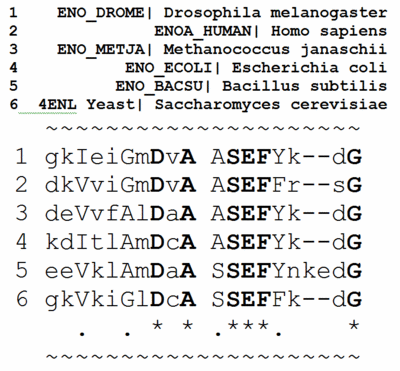Introduction to Evolutionary Conservation
From Proteopedia
Mutations occur spontaneously in each generation, randomly changing the amino acid sequences of proteins. Individuals with mutations that impair critical functions of proteins may have resulting problems that make them less able to reproduce. Harmful mutations are lost from the gene pool because the individuals carrying them reproduce less effectively. Over time, only harmless (or very rare beneficial) mutations are maintained in the gene pool. This is evolution.
Contents |
Examples
Consider the protein methyl CpG binding protein 2 (MeCP2; UniProt MECP2_HUMAN). Although its function is still unclear, it is expressed throughout the body, and disruption of its function causes problems with brain development and function[1]. Some mutations in MeCP2 cause Rett Syndrome, a severely debilitating condition affecting mostly women.
|
Effect of mutation on protein function |
Genetic consequence |
Example |
|
Function LOST** |
CONSERVED:
|
R133C* |
|
None |
NOT conserved:
|
E143?* |
|
* in methyl CpG binding protein 2 (MeCP2),
3c2i. Amino acid sequence in 1 letter code:
|
||
Locations of Mutations in 3D Model
|
The positions of conserved Arg133 and variable Glu143 are highlighted with yellow halos. You can see that conserved Arg133 is in intimate contact with the DNA, while variable Glu143 is on the surface, and remote from the contact with the DNA.
Finding Conservation
Evolutionary conservation in proteins is identified by aligning the amino acid sequences of proteins with the same function from different taxa (orthologs). As an example, we'll use the glycolytic enzyme enolase, present in a wide range of taxa. Take a quick look to get an impression of a multiple sequence alignment for ~400 amino acids in enolase for taxa ranging from eubacteria and archaebacteria through yeast, insects, and humans. In the full multiple sequence alignment is one segment highlighted in pink . This segment is enlarged below.
Notes and References
- ↑ MECP2 article in the National Library of Medicine's Genetic Home Reference


